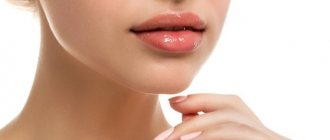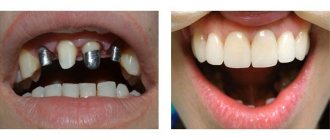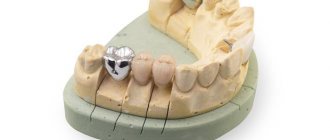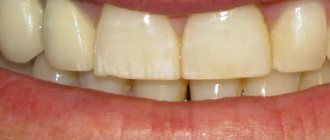Indications and contraindications Types After At home Is it harmful?
For children and pregnant women Differences from remineralization Effect Care after the procedure Fluoridation of teeth
- an effective way to protect teeth from caries and strengthen the enamel structure with the help of certain fluoridated agents.
Fluorine is an important element for the body; the daily requirement for it is about 3 mg. It comes to us with water and some food products. If it is not enough, then the connection between calcium compounds concentrated in the enamel is destroyed, the surface becomes vulnerable, which leads to increased sensitivity and damage to the tooth tissue.
What is dental fluoridation?
Fluoridation of teeth is an effective method of strengthening tooth enamel and protecting teeth from caries.
A deficiency of fluoride and calcium in the human body inevitably leads to the destruction of dentin (the main part of the tooth) and the enamel covering it. The result is increased tooth sensitivity, a tendency to develop caries, and periodontal disease.
Fluoridation is a painless and absolutely safe procedure, the essence of which is to apply a thin layer of fluoride-containing compounds (fluorides) to the surface of the teeth.
After fluoridation, it is recommended not to eat for several hours (4-6 depending on the drugs used), and also not to drink too hot or, conversely, cold drinks. In addition, you should refrain from eating solid food for 24 hours. These recommendations are due to the possibility of damaging the protective layer of fluoride applied to the teeth. If deep fluoridation has been carried out, you can eat and drink immediately.
Differences from remineralization
Any method of dentin fluoridation is part of remineralization, artificial saturation of the enamel structure with micro- and macroelements by applying dental pastes, gels rich in calcium, fluorine, phosphorus, magnesium, zinc, etc. to the surface. The procedures have the same goal - prevention of caries, strengthening of enamel and replenishment microelements lost during demineralization. If pastes and gels for remineralizing dental tissue contain several components, then fluoridation agents contain fluoride ions.
Fluoridation increases the rate of remineralization several times. Since fluoride varnish seals dentinal tubules, the use of mineral complexes should be separate. First, remineralization, the final stage is fluoridation of teeth.
Why coat your teeth with fluoride?
So what does fluoridation do? This method can be used by both adults and children to strengthen enamel and improve its strength properties.
Fluoride is an important element that not only makes enamel stronger, but also prevents the rapid proliferation of bacteria. Among other things, the resistance of teeth to an acidic environment increases, which means their surface becomes less susceptible to various types of destructive substances.
The fluoridation procedure must be repeated annually - then the teeth will be reliably protected from caries and not subject to premature destruction; The gradual leaching of calcium will stop, making the enamel stronger.
Criticism of the technique
However, in reality, the penetrating ability of sodium fluoride is no less than that of magnesium and copper fluorosilicates. It also penetrates deeply into the cracks and microcrawls of the enamel, and calcium fluoride forms not only on the surface. In addition, caries is not affected by those areas of the surface that are easily accessible to a toothbrush, but quite the opposite - hard-to-reach places where abrasion of the CaF2 layer will be minimal. The antibacterial effect of copper does not play any significant role. There are much more active antiseptics, but for protection against caries, the construction of fluorapatite crystals is much more important.
Types of fluoridation
Currently, fluoridation of teeth is carried out using two methods - simple and deep:
- Simple fluoridation . To carry out the procedure, special “spoons” are used that look like mouth guards, which are filled with a fluoride-containing composition and placed on the jaw for 10-15 minutes. To complete the full course, you need to conduct at least 10 sessions. An alternative option is simple fluoridation using a fluoride-containing varnish. It is applied with a special brush to the surface of the teeth and allowed to dry. The full course consists of 3-4 procedures, depending on the individual characteristics of the body and the drug used.
- Deep fluoridation . The main difference between this method and the previous one is the use of special enamel-sealing preparations. In addition, deep fluoridation requires careful preparation of teeth, therefore it is carried out exclusively in professional clinics. After the stage of cleaning the teeth, a special composition is applied to their surface using a tampon for 1-2 minutes, after which it is dried under the pressure of warm air. Then the surface of the teeth is stained with a swab dipped in calcium copper hydroxide milk, and then rinsed with clean warm water. The advantage of deep fluoridation is that the solution penetrates into the deep layers of enamel, making teeth much stronger. According to dentists, the effectiveness of deep fluoridation is 5 times higher than that of simple fluoridation.
Domestic preparations for deep fluoridation
The Russian industry, looking at the unprecedented popularity of the original drug Humanchemie, began to produce its generics. Our analogs of “enamel-sealing liquid” are “Flor-Lux kit for deep fluoridation” () and “Gluflutored” (“Vladmiva”). They also double as a “dentin-sealing liquid”:
In order to sell better, it would be desirable to support domestic medicines with references to their own effectiveness. That’s what was done, but the level of evidence turned out to be phenomenal. The developers did not bother to order a study even from the very last department of the Russian institute, and without any hesitation advertise their drug based on the result of school laboratory work:
Benefit
As already mentioned, the main goal of fluoridation is to strengthen tooth enamel. In addition, there are other advantages of this procedure:
- The sensitivity of the teeth is reduced, so there is no discomfort when consuming cold and hot food or drinks.
- The risk of developing caries is reduced due to a reduction in the number of pathogenic bacteria and increased resistance of teeth to an acidic environment.
- Fluoridation prevents calcium from being washed out of tooth enamel, making teeth stronger and stronger.
Harm
As you know, you need to know moderation in everything. Those who like to experiment with various fluoride-containing drugs need to know the following:
- Fluorides are toxic substances that in large quantities can cause serious harm to the human body. Therefore, if you prefer to use toothpastes with fluoride, then it is better to refrain from the fluoridation procedure. And vice versa - if you have coated your tooth enamel with fluoride, then you should choose toothpastes that do not contain this chemical element.
- Fluorosis is an excessive accumulation of fluoride in the body. Fluorosis leads to brittle bones, anemia, and neuralgic abnormalities. As for teeth, when fluoride accumulates excessively in them, the enamel begins to rapidly deteriorate, which invariably affects their appearance.
Fluoridation of teeth during pregnancy
During the period of bearing a child, most of all nutrients and minerals from a woman’s body go to the formation of the skeleton and muscle tissue of the unborn baby. Due to calcium deficiency during pregnancy, tooth enamel is destroyed, so fluoridation during this period is very useful. However, before applying fluoride to your teeth, you should have your mouth examined and consult an experienced dentist.
It is important to remember that severe toxicosis is the main contraindication to the procedure, so it is best to plan a trip to the dentist for the 2-3 trimester, when the pregnant woman’s health improves. During breastfeeding, the fluoridation procedure will also not be superfluous.
Ozone therapy in the treatment of caries
An innovative technique for the treatment of caries and other oral diseases. A special device converts oxygen into ozone, which deeply disinfects the affected areas and kills pathogens. The effect occurs as follows: the dentist brings the silicone tip of the device to the teeth, through which gas is supplied.
Ozone can eliminate up to 90% of microorganisms; in addition, the procedure has undoubted advantages:
- does not cause allergies and can be used even to treat very young patients;
- passes quickly - the effect lasts approximately 30-40 seconds;
- disinfects root canals, which minimizes the risk of re-development of the disease;
- the condition of the gums and the entire oral cavity improves.
Ozone therapy is a very comfortable way to solve dental problems. It is not used on its own - the procedure is usually carried out in general complex therapy before fluoridation or remotherapy.
Contraindications and indications
To the question “When should you resort to dental fluoridation?” there is no clear answer. Dentists suggest performing it for children and adults as a preventive measure for caries, but there are other indications for coating teeth with fluoride-containing compounds:
- Increased sensitivity. As a rule, it manifests itself in the form of discomfort when eating cold foods or drinks, fresh fruits or vegetables. Fluoridation helps strengthen the enamel, thereby reducing dentin sensitivity.
- Tendency to develop caries. If you often visit dentists for dental treatment, then fluoridation is an excellent way to extend the life of your fillings and also prevent the formation of new enamel damage.
- Recent gum disease.
- Accumulation of a large amount of yellow plaque at the base of the tooth (above the gum).
- The fluoridation procedure is also carried out after removing braces.
- For children 6 years of age and older, fluoridation is recommended to prevent tooth decay and to maintain overall dental health.
Contraindications include only individual intolerance to certain elements of fluorine-containing formulations, as well as an excess of fluoride in the body. If the patient lives in an area where the fluoride content in the water is quite high, in this case the doctor will most likely offer you other preventative procedures to protect and strengthen the enamel.
Treating stains and protecting enamel around braces
Sometimes fluoridating teeth with Clinpro™ WhiteVarnish is not enough. For example, these are the cases:
- when, after fluoridation, the patient retains tooth sensitivity in some areas
- when caries is detected in the initial stage of the “white” spot
- when a patient is undergoing orthodontic treatment and there is a risk of white chalky spots forming around the installed braces.
In these cases, the application of Clinpro® XT Varnish is recommended. During the procedure, the doctor cleans and dries problem areas, applies material to the cleaned surface and illuminates it with a polymerization lamp.
After six months, when the effect of the drug wears off, you need to visit the dentist again. The doctor will evaluate the outcome of the treatment and, if necessary, recommend repeating the fluoridation procedure with Clinpro® XT Varnish.
DLclinic dentists recommend fluoridation of teeth only in a doctor’s office, or (for home fluoridation) after consultation with a dentist, since fluoride can be dangerous to the body in excessive concentrations. Only a doctor can determine whether fluoridation is indicated for a particular patient. Carrying out the procedure independently and uncontrolled can lead to a number of negative consequences. Consult your dentist about the benefits and method of dental fluoridation recommended in your particular case.
Stages of the procedure
Regardless of the chosen fluoridation method, this procedure includes the following steps:
- Oral hygiene. This can be either a full professional cleaning (removal of plaque and tartar), or a simple treatment with antiseptic dental compounds. The tooth surface must be clean before applying fluoride-containing compounds so that the mineral substances can protect the enamel.
- Thorough drying with warm air.
- Depending on the chosen method of fluoridation, either fluoride-containing varnish is applied to the teeth, or a mouth guard with a special paste is put on for 10-15 minutes.
- During deep fluoridation, the surface of the teeth is covered with an enamel-sealing liquid, which is thoroughly dried and carefully shaded. After 1-2 minutes, rinse the oral cavity.
It is also important to understand that fluoridation is advisable only on healthy teeth, so before the procedure it is imperative to sanitize the oral cavity.
Prof. hygiene with 20% discount
Moscow
Fluoride-containing drugs: myths and reality
L. A. Lobovkina
Ph.D., doctor of the highest category, head of the treatment and prophylactic department of Branch No. 6 of the Federal State Institution “GVKG im. Burdenko" of the Ministry of Defense of the Russian Federation
L. V. Rainauli
Candidate of Medical Sciences, Head of the Dental Department of Branch No. 6 of the Federal State Institution “GVKG im. Burdenko" of the Ministry of Defense of the Russian Federation
A. M. Romanov
chief physician of the Implamed clinic (Moscow)
Currently, Russia occupies one of the last places in carrying out measures to prevent dental diseases. This is explained by the fact that in most cases, doctors have only fragmentary information about the range of means and methods of prevention, as well as a lack of experience and a comprehensive individual approach to carrying out preventive measures [3].
At the same time, global experience in the development and implementation of preventive programs in society has shown that individually focused programs are the most effective [5].
One of the most studied substances that prevent the development of caries is fluoride [6]. Is there a real alternative to fluorides?
- Hygiene products containing xylitol contribute to disruption of the energy metabolism of the main cariogenic species Str. Mutans and stimulate salivation. However, data are conflicting and questions remain about dosage, frequency of administration, and optimal routes of administration.
2 . Products containing chlorhexidine have antibacterial activity against most pathogenic microorganisms of the oral cavity. But when using such products, it is possible to change the composition of the normal microflora (dysbiosis), stain the surface of the teeth and tongue, and disrupt the sense of taste.
3. CPP-ACP (“Rekaldent”) - casein-phosphopeptide-amorphous calcium phosphate. Casein phosphopeptide, due to its adhesiveness, is fixed on the surface of the teeth and serves to transport calcium and phosphate ions to the surface layers of the enamel. However, the quantity and quality of available studies do not allow us to conclusively state the advantage of the Recaldent system over fluoride-containing drugs.
4. Oral hygiene products with bioactive microcrystals. They contain hydroxyapatite, zinc, calcium phosphate and other components, which, according to manufacturers, fill enamel microdamages for a long time, unlike fluorides, which have an exclusively superficial effect. However, such statements lack an evidentiary basis, since there is no literature data comparing the effectiveness of these products with fluoride-containing ones (Kuzmina E. M., 2011).
Considering the fact that the preventive effect of these drugs does not have sufficient evidence, they can be prescribed to patients at high risk of developing caries only as measures that complement the action of fluoride (Maslak E. E., 2015).
Rice. 1. Teeth 31, 41, 32, 42 - initial situation. Rice. 2. Teeth 31, 32, 41 and 42: coating with fluoride varnish VOCO “Profluoride Varnish”
Rice. 3. Teeth 31, 32, 41 and 42 - final appearance. Rice. 4. Teeth 3.3 and 3.4 - initial situation.
Rice. 5. Teeth 3.3 and 3.4 – coated with fluoride varnish “Bifluoride 12”. Rice. 6. Inflating with air “Bifluoride 12”. Rice. 7. Teeth 3.3 and 3.4 - final appearance.
It is advisable to note that the main substance for the prevention of a number of dental diseases has been and remains fluoride! It has been established that topical fluoride-containing products are effective for the prevention of caries in both temporary and permanent teeth [4].
In addition, a number of studies indicate that fluoride is also effective for the prevention of tooth root caries, so it should be used in all age groups (Kuzmina E. M., Smirnova T. A., 2001).
At the same time, there is an opinion among doctors that fluoride is harmful. However, Paracelsus also said: “Everything is poison, everything is medicine; both are determined by the dose.” Therefore, preference should be given to exogenous methods of prevention, which are more controlled and safe compared to endogenous ones.
Today, the dental market has a wide range of drugs for fluoridation of hard dental tissues.
To prevent and treat the initial manifestations of caries, fluoride-containing gels and varnishes are used. Gels typically contain low concentrations of fluoride and are recommended for weekly home use for persons over 18 years of age [2].
Unlike gels, fluoride-containing varnishes can remain on the tooth surface for a long time, thus promoting the accumulation of more fluoride in the enamel [1]. This is especially important at a time when demineralization processes predominate. However, when applying conventional fluoride varnishes, calcium fluoride crystals are freely located on the surface and are quickly removed by mechanical abrasion, making the effect short-lived. Therefore, preference should be given to drugs that have a longer effect.
“ VOCO Profluoride Varnish ” is a fluorine-containing varnish based on a special resin (colophonium) with a 5% sodium fluoride content. Fluoride ions, together with calcium ions present in the tubules, promote the precipitation of calcium fluoride, which leads to reliable sealing of the dentinal tubules. Due to this, the varnish is effective for the treatment of hypersensitivity. Along with this, VOCO Profluoride Varnish forms a depot of calcium fluoride on the tooth surface, which protects the tooth from acid attacks, promotes remineralization and the formation of fluorapatite. In addition, xylitol has been added to the varnish, which, while improving taste characteristics, has a proven cariostatic effect. Colonium resin provides good adhesion, also on wet surfaces. Therefore, the drug can be used even if it is impossible to dry the surface of the teeth well! Thus, the use of this drug significantly saves time.
Clinical case No. 1
Patient I., 47 years old, applied to a therapeutic dentistry clinic with complaints of pain from temperature and chemical stimuli in the area of 31, 32, 41 and 42 teeth.
When carrying out objective research methods, recession of class I periodontal tissues according to Miller was discovered in the area of 31, 32, 41 and 42 teeth, as well as wedge-shaped defects of these teeth (Fig. 1: Teeth 31, 41, 32, 42 - initial situation). A diagnosis was made: teeth 31, 32, 41 and 42 - wedge-shaped defects, hypersensitivity.
The surfaces of the teeth were cleaned using a fluoride-free paste and a brush, then coated with fluoride-containing varnish “VOCO Profluoride Varnish” (Fig. 2: Teeth 31, 32, 41 and 42 - coated with fluoride varnish VOCO Profluoride Varnish. Fig. 3: Teeth 31, 32, 41 and 42 - final appearance).
“Bifluoride 12 ( VOCO )” is a unique transparent fluoride varnish, which is a colorless suspension based on natural tree resin with a pleasant fruity smell and taste. The main active components of Bifluoride 12, unlike all existing fluoride varnishes, are 6% sodium fluoride and 6% calcium fluoride. Due to sodium fluoride, the drug begins to act instantly, immediately after its application, and due to calcium fluoride, it has better penetrating ability, having a long-term therapeutic effect: fluoride is released over several months.
The varnish also contains bioinert Teflon particles, which give it strength properties.
The advantage of “Bifluoride 12” is that it forms a waterproof, smooth protective film that helps insulate from thermal and chemical irritants, which prevents dental plaque from fixing on its surface. In addition, the varnish dries quickly, so to obtain long-term adhesion to the enamel, it should be applied in a thin layer. To maintain the anti-caries effect, re-coating must be carried out after 3-6 months. Single-layer application of varnish saves the doctor’s time and minimizes consumption; Bifluoride 12 is on average 66% more economical than its analogues.
In addition, “VOCO Profluoride Varnish” and “Bifluoride 12” are excellent desensitizers that provide pain relief for hypersensitivity for several months.
Clinical case No. 2
Patient Yu., 36 years old, came to the clinic of therapeutic dentistry with complaints of pain in the area of 3.3 and 3.4 teeth that occurred under the influence of temperature and chemical irritants.
When carrying out objective research methods, hypersensitivity of teeth 3.3 and 3.4 was revealed, which arose after eating citrus fruits (Fig. 4: Teeth 3.3 and 3.4 - initial situation). After cleaning teeth 3.3 and 3.4 using a fluoride-free paste and a brush, Bifluoride 12 was applied (Fig. 5: Teeth 3.3 and 3.4 - coating with fluoride varnish Bifluoride 12. Fig. 6: Blowing with air Bifluoride 12. Fig. 7: Teeth 3.3 and 3.4 - final view).
Thus, given the high level of evidence for the use of fluorides in the prevention of dental caries, it is necessary to use them widely in both children and adults (Maslak E. E., 2015). The doctor’s availability of fluoride-containing varnishes (“VOCO Profluoride Varnish” and “Bifluoride 12”), as well as knowledge of the schemes for their use, allows not only to be confident in the proposed method, but also to provide the opportunity to demonstrate the results obtained to the patient, which, undoubtedly, increases the image of the doctor and the attractiveness of professional prevention in general and, therefore, creates the basis for long-term regular communication [3].
Fluoridation of teeth at home
Currently, preparations for fluoridation of teeth can be purchased in pharmacies or specialized clinics. Fluoride varnish is an effective remedy for strengthening teeth at home, but it should be used carefully and only after consultation with your dentist.
In order for fluoridation to bring visible results, it is necessary to take care of the cleanliness of your teeth. Next, you need to strictly follow the instructions included with the drug. Fluoride varnish should be used in courses - 3-4 procedures.
The most common way to strengthen tooth enamel is to use toothpastes containing fluoride. However, it is worth remembering that you cannot use these products for a long time - you need to alternate them from time to time with other drugs that do not contain fluoride.
ICON caries treatment method
The German treatment technology ICON has long been known in Europe. And now it is gaining popularity in Russia as an effective method for treating carious teeth in adults and children, starting from the age of three. Like other methods, it is used only at the early stage of the disease.
Before starting the ICON procedure, the doctor thoroughly cleans the patient’s teeth and removes deposits. Then, using a special nozzle, a gel containing hydrochloric acid is applied to the affected area of the tooth. The effect of the drug lasts for 2 minutes, and during this time the surface layer is removed, opening access to the porous area of the tooth, where resolution began.
Next, the dentist washes off the gel with a stream of water and air, thoroughly dries the surface of the tooth, and then sees the full extent of the damage to the surface layer. The doctor consistently applies the infiltrate to the chalk stain, thereby sealing the carious lesions and preventing further destruction.
The ICON procedure has many attractive points:
- accessible to the youngest patients without causing fear in them;
- used to treat baby teeth that are not recommended to be filled;
- Several teeth can be treated in one session;
- not only therapeutic but also aesthetic results are achieved.
Treatment using ICON technology protects tooth enamel from the destructive effects of cariogenic bacteria.
Fluoridation and silvering: what is the difference?
The silvering method is the treatment of teeth with preparations containing silver nitrate. This method of combating caries is prescribed to the youngest children - up to 3 years old. The procedure is quick and painless: saliva is removed from baby teeth, then they are impregnated with a silver preparation. Silvering is used only at the initial stage of caries - “white spots”, and can stop the development of the disease, but does not cure it. In addition, a big disadvantage is the darkening of the teeth as a result of the procedure.
In dentistry, this method is now almost never used, giving way to a more effective fluoridation technique. The procedure is as simple as silvering, but it has advantages over the latter: fluoridation not only prevents the development of caries, but also strengthens tooth enamel.
Definition of etiotropic and pathogenetic therapy
The main thing in the treatment of initial caries is the therapeutic effect on the factors causing the disease (etiotropic therapy) and the mechanisms that prevent its further development (pathogenetic therapy).
The goal of etiotropic treatment of caries is to eliminate soft plaque from the affected tooth surface, remove destroyed particles of enamel and dentin in order to isolate the inner surface of the carious cavity. But pathogenetic treatment aims to increase the resistance of dental structures to external influences and enhance their ability to regenerate. Both types of therapy are provided without drilling or filling, only by removing soft plaque from the enamel, taking medications, and applying remineralizing solutions. General treatment of initial caries is advisable when the size of the spot is no more than 6 mm.
After carrying out a set of non-invasive therapeutic measures for dental treatment, it is recommended to visit the dentist once every six months for a follow-up examination. The treatment is completely completed only when the chalk spot significantly decreases in size or disappears completely, and its stainability when tested with caries markers is weakened. General monitoring of the condition of dental structures continues for up to two years after treatment. In case of repeated development of caries with damage to the enamel, surgical and restorative treatment is indicated.








